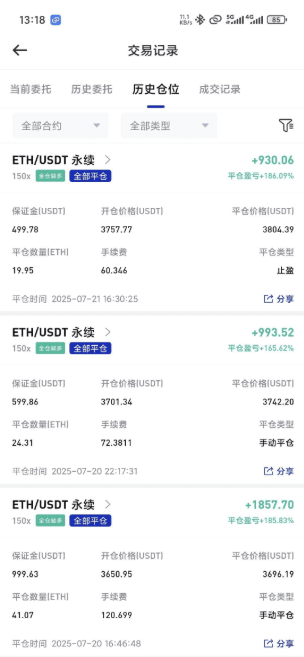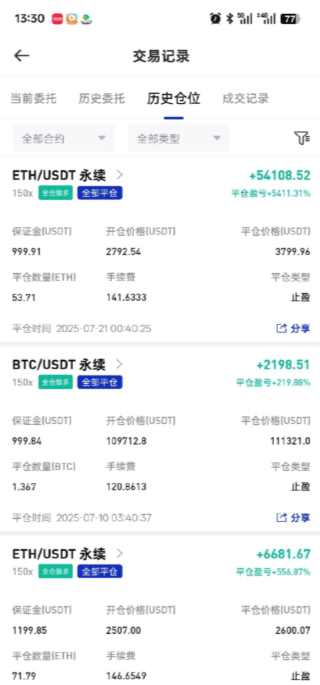I've seen someone roll 5000 to 1 million in half a year, and someone earn 500,000 one day and lose it all the next—this isn't a difference in luck, but a stark contrast in executing the rolling strategy. After 4 years of practical experience in contracts, I've encountered enough pitfalls to fill a truck, and the two core words I concluded from my tactics are 'guard' and 'ruthless'—be as steady as a mountain when guarding, and never be soft when being ruthless.
1. Wait: 90% of the time wait, 10% of the time earn.
Newbies in contracts always feel 'not trading means losing'; it feels uncomfortable not to open a position for a day. But those I've seen who can make money are all 'snipers'—90% of the time they lie still, waiting for the best moment to pull the trigger.
Last year, a follower started with 5000; in the first three months, he traded every day, spending over 800 on fees, and his account was down 30%. Later, he learned from me to 'wait for the market' and only acted when BTC or ETH showed 'violent trends': for example, breaking key resistance levels or surging over 5%. As a result, in the fourth month, he made 40% on a single trade, equivalent to the chaotic efforts of the previous three months.
What is a 'violent market'? There are three signals:
Breaking through key levels + increased volume: BTC was consolidating at 30,000 for half a month, suddenly a large bullish candle broke through 32,000 with volume three times that of the previous day—this indicates 'capital is scrambling to buy', entering at this time likely leads to over 10% volatility within 3 days.
Trend driven by news: After major news like the Federal Reserve announcing an interest rate cut or Bitcoin halving comes out, the market often continues for a while. Last year on the day the Federal Reserve cut rates, I waited 2 hours to confirm the trend, then entered the market, earning 30% in 5 days.
Sector-linked rise: for example, if the DeFi sector rises collectively, and the leading coin rises by 10%, other coins will follow—this indicates 'it's not just a single coin's market, but a sector opportunity', which is safer.
The core of waiting for the market is 'holding back'. I have a timer on my phone, forcing myself to 'open a maximum of 2 trades per day'; before opening a position, I must stare at the candlestick for 15 minutes, which suppresses many impulsive trades. Remember: In the contract market, missing 10 opportunities is not scary; what’s scary is one impulse that wipes out the principal.
2. Roll: use profits to roll; the principal is always a 'safety cushion'.
'Adding to the position after making money' is a fatal flaw for contract newbies. I once made 50% on ETH, impulsively added all my principal and profits, only to see the market reverse, losing not just profits but 20% of my principal. It was only later that I understood: principal is 'life', profits are 'the icing on the cake', and they cannot be confused.

Now my operational iron rule is:
In the first trade, profit first withdraw the principal: 5000 principal, first trade earned 1000 (20%), immediately transfer the 5000 principal out, continuing with only 1000 profit. This way, even if the following trades lose, it’s just losing earned money, and the principal remains intact.
Rolling profits, step-by-step increase: when profits reach 2000 (doubled), increase position by a maximum of 50% (1000); at 4000, add 50% (2000). Always leave a 'buffer zone' for profits, not putting all eggs in one basket.
After doubling, keep a safety cushion: profit doubles (for example, 1000 becomes 2000), immediately withdraw 30% (600) to a stablecoin wallet, and the remaining 1400 continues to roll. This 600 is the 'safety cushion'; even if there are losses later, you have securely pocketed 600.
Last year, there was a month when I rolled with a profit of 10,000, doubling twice in the process, withdrew 30% as a safety cushion, and even though the market later retraced, I still made a net profit of 12,000—many people can't make money because they treat 'paper profits' as 'actual gains', not understanding 'pocketing for safety'.
3. Adjust: let the stop-loss line follow the profit; don’t do 'roller coaster'.
'After earning 50%, move the stop-loss line to the cost price'—this is a lesson I learned from using a 30,000 loss.
When I first started trading contracts, I always set the stop-loss line at 3% below the opening price. As a result, there was an occasion when ETH pulled back from a 50% profit to a 10% profit, and I didn't act, thinking 'it can bounce back', only to see it drop to the stop-loss line, losing not only profits but also 3% of my principal.
Now I have learned 'dynamic stop-loss adjustment':
For floating profits within 50%, set the stop-loss line 3% below the opening price (conventional stop-loss).
Floating profit exceeds 50%, adjust the stop-loss line to 'opening price' (cost price), ensuring 'no loss of principal'.
Floating profit exceeds 100%, adjust the stop-loss line to 'opening price + 50%', locking in half the profit.
Once, with SOL floating profit of 80%, I moved the stop-loss line to the cost price. Later, it pulled back to 2% above the cost price, and I didn't stop loss; in the end, it rose another 50%—I preserved profits and didn't miss the opportunity. The core of this trick is 'let profits protect themselves'; if it rises, earn more, if it falls, don't lose, keeping a stable mindset.
4. Stop: not being able to hold onto profits is equivalent to earning nothing.
'Not taking profits leads to a last empty trade'—this is the cruel truth of the contract market. I've seen too many people, with floating profits of 50% or 100%, unwilling to sell, only to see the market reverse and lose all profits, even going into the red.
My profit-taking principle is 'take profits in batches, seize the opportunity when it arises':
Floating profit of 30%, take 30% profit: for example, entering with a profit of 10,000, earning 3000, first sell 30% (position corresponding to 3000 of principal), recovering 900 profit.
Floating profit of 50%, then take 40% profit: the remaining 7000 position earned 3500, then sell 40%, recovering another 1400.
Floating profit of 100%, either liquidate or keep 10% to gamble on the market: for the remaining 30% position, either sell all or keep 10% to bet higher, but never be greedy.
In last year’s BTC market, I used this profit-taking method and liquidated at a floating profit of 120%. Even though it later rose another 50%, I had already made 120%—many people always think about 'selling at the highest point', but end up not capturing even a 'relative high point'.
The core of profit-taking is 'accepting imperfection'. There is no 'selling at the highest point' god in the crypto world; being able to pocket most of the profits during an uptrend already beats 90% of people.
Why can some people roll from 5000 to 1 million, while others lose everything after earning 500,000?
The former understands 'wait': only act in confirmed market situations, lurking like a hunter, not acting unless sure.
The former understands 'roll': use profits to play; the principal is always safe, maintaining a stable mindset means no distortion in operation.
The former understands 'adjust': dynamically adjust the stop-loss to let profits bear risks themselves; earn more when it rises and don’t lose when it falls.
The former understands 'stop': take profits when you can, don’t be greedy; preserving profits is more important than pursuing 'higher' returns.
The latter, however, often represents 'not waiting, rolling randomly, not adjusting, not stopping'—as soon as the market comes, they rush in, add principal when they earn, leave stop-losses unchanged, and rely on fantasies for profit-taking; it's no surprise if they end up losing everything.
Finally, a piece of advice for those wanting to turn their fortunes by rolling:
The core of the rolling strategy is not 'how quickly to earn', but 'how long to live'. Rolling 5000 to 1 million relies not on a single windfall, but on countless times of 'waiting for the right market, using profits to roll, adjusting stop-loss, and timely profit-taking'.
You don't need to become a 'contract master', just execute these details: be patient when you need to wait, use profits when you need to roll, adjust when necessary, and don't be greedy when you should stop. Achieving these, even if you can't roll 200 times, you can at least survive longer in the crypto world, and surviving longer will allow you to wait for your own opportunity.
The crypto market changes rapidly, but those who can make money are always those who 'know how to control themselves'. Don't be led by market fluctuations; from today, engrave every step of the rolling strategy in your mind. Next time the market comes, you will thank yourself today.
